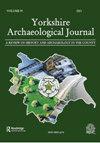Wakefield, its Woollen-Cloth Trade and Merchant Networks, 1558-1650
IF 0.2
0 ARCHAEOLOGY
引用次数: 0
Abstract
Abstract Towns cannot be fully understood without a knowledge of their interactions with each other. This was never more true than at a time when the textile industry was both ubiquitous and of national importance. The industry had an influence over the largest city and the smallest cottage. Trade was a way in which many people saw their own area as a part of the national picture. Here, using a wide range of primary sources including wills, leases, court cases, taxation records and government surveys, the cloth trade of early-modern Wakefield has been partially reconstructed. Particular attention is paid to the network of towns and regions Wakefield traded with, and the reciprocal nature of this trade. Case studies illustrate how and why trading developed.韦克菲尔德,其羊毛布贸易和商人网络,1558-1650
如果不了解城镇之间的相互作用,就无法完全理解城镇。在纺织业无处不在且具有国家重要性的时代,这一点从未如此真实。这个产业对最大的城市和最小的农舍都有影响。贸易是许多人将自己的地区视为国家图景的一部分的一种方式。在这里,使用了广泛的主要来源,包括遗嘱、租约、法庭案件、税务记录和政府调查,现代早期韦克菲尔德的布料贸易得到了部分重建。特别关注韦克菲尔德贸易的城镇和地区网络,以及这种贸易的互惠性质。案例研究说明了交易是如何发展的以及为什么发展的。
本文章由计算机程序翻译,如有差异,请以英文原文为准。
求助全文
约1分钟内获得全文
求助全文

 求助内容:
求助内容: 应助结果提醒方式:
应助结果提醒方式:


